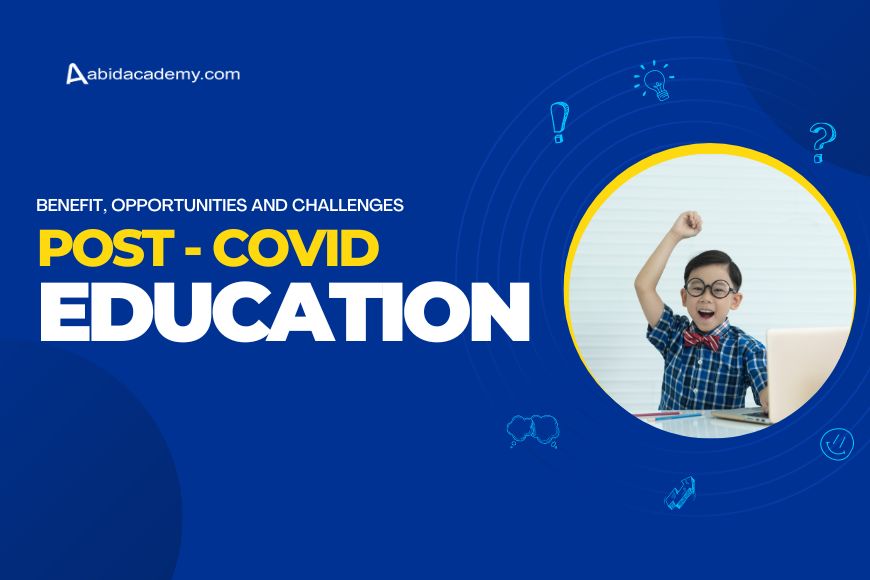
The Challenges, Benefits, and Opportunity Of Post-Covid Education
The world has changed drastically due to the COVID-19 pandemic, and education is no exception. The COVID-19 pandemic has had a profound impact on education, forcing schools and universities to close and move to online learning. This has led to a number of challenges, including:
- Disruptions to learning
- Inequity in access to education
- Increased stress and anxiety among students
However, the pandemic has also created some opportunities for innovation and improvement in education. In this article, we’ll explore the benefits and challenges of post-COVID education and how it can be used to create a better learning environment for students. From virtual learning to more interactive experiences, let’s find out how post-Covid education can transform the way students learn and succeed in their academic pursuits!
Table of Contents
What is post-COVID education?
The education system has been through a lot of changes in the last few years. With the outbreak of the pandemic, many schools and universities had to close their doors and move to online learning. This was a big adjustment for everyone involved, and it’s still not clear what the long-term effects of this will be. However, there are some potential benefits of post-COVID education that are worth considering.
- One benefit is that students will have more opportunities to learn from home. This is especially beneficial for those who don’t live in areas with good access to quality education. With online learning, they can get the same education as their peers without having to leave home.
- Another benefit is that online learning can be more flexible than traditional classroom learning. This means that students can take courses at their own pace and on their own schedule. This can be helpful for those who have busy schedules or who need to take care of other commitments outside of school. There are many online learning platforms available including Udemy, Coursera, abidacademy, They provide self-paced and personalized learning environments.
- Finally, online learning can also help prepare students for the future. With the world becoming increasingly digital, it’s important for students to be comfortable with using technology for learning. By taking courses online, they’ll be better prepared for a future where they might need to use these skills in their career.
How has the COVID-19 pandemic affected education?
The COVID-19 pandemic has had a profound impact on education, forcing schools and universities to close and move to online learning. This has led to a number of challenges, including:
- Disruptions to learning: Students have missed out on classroom instruction and social interaction.
- Inequity in access to education: Not all students have equal access to technology and the internet, making it difficult for them to participate in online learning.
- Increased stress and anxiety among students: The pandemic has created a lot of uncertainty and anxiety for students, which can make it difficult to focus on their studies.
However, the pandemic has also created some opportunities for innovation in education. For example, schools and universities have had to develop new ways to deliver instruction, such as using online platforms and video conferencing. This has led to the development of new technologies and teaching methods that could be used in the future.
Schools and universities closed and moved to online learning
The COVID-19 pandemic forced schools and universities to close their doors and move to online learning. This was a major challenge for both students and teachers. Students had to learn how to use new technologies and adapt to a new learning environment. Teachers had to learn how to teach online and keep their students engaged.
Despite the challenges, online learning has some potential benefits. It can be more flexible and convenient for students, and it can allow students to learn at their own pace. It can also be more accessible to students who live in rural areas or who have disabilities.
However, there are also some challenges to online learning. It can be difficult for students to stay motivated and engaged, and it can be difficult for teachers to provide the same level of support as they would in a traditional classroom.
This led to challenges and opportunities for innovation
The move to online learning has led to a number of challenges and opportunities for innovation in education. One challenge is the digital divide. Not all students have equal access to technology and the internet, which can make it difficult for them to participate in online learning.
Another challenge is the need for teacher training. Teachers need to be trained on how to use technology effectively in the classroom, and they need to learn how to teach online.
However, the move to online learning has also created some opportunities for innovation. For example, new technologies have been developed that can be used to deliver instruction online. These technologies can be used to personalize learning, provide access to resources, and connect students with each other and with experts.
The move to online learning has also created an opportunity to rethink the way we teach and learn. We can now use technology to create more personalized and engaging learning experiences. We can also use technology to connect students with each other and with experts from around the world.
The future of education is uncertain, but the move to online learning has created some opportunities for innovation. By embracing these opportunities, we can create a better future for education.
How does a post-COVID education compare to traditional education?
Pre-Covid, most education was conducted in physical classrooms with teachers and students together in person. Pros of this system include the ability to ask questions and get immediate feedback, as well as the ability to develop social skills by interacting with classmates. However, there are also several cons, such as the risk of exposure to illnesses and the difficulty of accommodating different learning styles in one classroom.
| Aspect | Post-COVID Education | Traditional Education |
|---|---|---|
| Learning Format | Hybrid | In-person |
| Technology Integration | Extensive | Limited |
| Classroom Interaction | Reduced | High |
| Learning Flexibility | High | Limited |
| Access to Education | Improved | Limited |
| Assessment and Evaluation | Varied | Standardized |
| Time Management | More Autonomous | More Structured |
| Collaborative Learning | Digital Collaboration | Face-to-Face |
| Teacher-Student Relationship | More Remote | More Personal |
Note: This table provides a general comparison between post-COVID education and traditional education, but it may vary depending on the specific circumstances and educational institutions.
Post-Covid, many educational institutions have switched to online learning platforms like Zoom or Google Meet. While this does have some advantages – like increased flexibility for students with different schedules – it also has its own set of challenges, such as tech problems and a lack of human interaction.
Benefits of a post-COVID education
The COVID-19 pandemic has had a profound impact on education, forcing schools and universities to close and move to online learning. This has led to a number of challenges, but it has also created some opportunities for innovation and improvement.
Post-COVID education will need to be more flexible, personalized, and focused on digital skills. Here are some of the benefits of this new era of education:
Increased flexibility and choice
One of the biggest benefits of post-COVID education is that it will be more flexible. Students will be able to learn from anywhere, at any time, and at their own pace. This is a major advantage for students who have busy schedules or who need to work while they learn.
Improved digital skills
Another benefit of post-COVID education is that it will help students improve their digital skills. Students will be more comfortable using technology for learning, and they will be better able to collaborate and communicate online. This is an essential skill for success in the 21st-century workforce.
Stronger problem-solving and critical thinking skills
The COVID-19 pandemic has forced students to think more creatively and independently. They have had to learn how to solve problems and think critically in a digital world. These are essential skills for success in any field.
Greater empathy and understanding
The pandemic has also helped students develop greater empathy and understanding for others. They have seen firsthand the challenges that people face, and they are more likely to be compassionate and understanding. This is an important skill for building strong relationships and creating a better world.
Increased focus on mental health and well-being
The pandemic has also highlighted the importance of mental health and well-being. Schools and universities are paying more attention to student mental health, and they are providing more resources and support. This is a positive step towards creating a more holistic and supportive learning environment.
A more personalized learning experience
Post-COVID education will also be more personalized. Students will have more opportunities to learn at their own pace and in a way that suits their individual needs. This is a more effective way to learn, and it is also more likely to keep students engaged and motivated.
Challenges and opportunities
There are a number of challenges that need to be addressed in order to create a successful post-COVID education system. These include:
- Overcoming the digital divide: Not all students have equal access to technology, so it is important to find ways to bridge the digital divide.
- Addressing the needs of all learners: There is a wide range of learners with different needs, so it is important to find ways to meet the needs of all learners.
- Ensuring quality and equity in education: It is important to ensure that all students have access to high-quality education, regardless of their background or circumstances.
Despite these challenges, there are also a number of opportunities to improve education in the post-COVID era. These include:
- The use of technology: Technology can be used to personalize learning, provide access to resources, and connect students with each other and with experts.
- The focus on problem-solving and critical thinking: These skills are essential for success in the 21st-century workforce.
- The development of empathy and understanding: These skills are essential for building strong relationships and creating a more just and equitable world.
Who should go on to post covid education?
There is no one-size-fits-all answer to this question, as the decision of whether or not to pursue post-COVID education will depend on each individual’s unique circumstances. However, there are some general factors that could help you decide whether or not post-covid education is right for you.
If you’re struggling in your current educational situation, whether that’s because of Covid-19-related disruptions or other reasons, then post-covid education could be a good option for you. Pursuing further education can help you catch up on what you’ve missed and give you the opportunity to improve your grades.
Taking courses in a variety of subjects can give you a better sense of what interests you and what skills you need to develop. Ultimately, the decision of whether or not to go on to post-COVID education should be based on what will work best for YOU. Consider your personal circumstances and goals, and make a decision that will help you achieve success in the long run.
The future of education
The future of education is bright. By focusing on flexibility, personalization, and digital skills, we can create a learning environment that is both effective and supportive for all students.
Conclusion
The post-Covid era has brought about a dramatic shift in the way we approach education, and it appears that many of these changes are here to stay. The benefits of embracing technology, providing more flexible learning options, and creating personalized curriculums are just some of the ways that this new educational landscape is benefiting students from all backgrounds.
Although there will undoubtedly be challenges ahead as we adjust to a “new normal” way of teaching, with careful planning and thoughtful adaptation to modern technology, schools can create an optimal learning environment for everyone.
FAQ: Frequently asked questions:-
What are the main benefits of pursuing education after COVID-19, and how can it help me in my career or personal growth?
The benefits of pursuing education after COVID-19 include gaining new skills and knowledge, improving employability, increasing earning potential, enhancing personal growth and self-confidence, and adapting to the changing world. It can help you stay competitive in the job market and keep up with industry trends and technological advancements.
How has the pandemic affected the traditional education system, and what changes have been made to adapt to the new normal?
The pandemic has forced the education system to adopt new strategies, such as online learning, hybrid models, and virtual classrooms, to maintain continuity in education. These changes have made education more accessible and flexible, allowing learners to access education from anywhere and at any time.
What are the different forms of post-COVID education, such as online courses, distance learning, or hybrid models, and how can I choose the right option for me?
Post-Covid education can take many forms, including online courses, distance learning, hybrid models, and in-person classes. The right option for you depends on your personal preferences, learning style, and schedule. It’s important to choose a program that fits your lifestyle and meets your educational goals.
What skills or knowledge should I focus on learning to prepare myself for the changing job market or industry trends in a post-Covid world?
To prepare for the changing job market or industry trends in a post-Covid world, learners should focus on gaining skills that are in high demand, such as digital literacy, communication, critical thinking, and problem-solving. These skills are transferable and can be applied to various fields and industries.
How can I stay motivated and engaged while learning remotely, and what are some tips for balancing my work, personal life, and educational goals?
To stay motivated and engaged while learning remotely, learners should establish a routine, set realistic goals, connect with peers and instructors, and take breaks when needed. It’s important to find a quiet and comfortable study space, eliminate distractions, and manage time effectively. Seeking support from friends, family, or online communities can also help maintain motivation and accountability.
Tag:corona benefits to nature, covid 19 education crisis, covid 19 education news, covid 19 impact on education, covid 19 impact on education essay, covid 19 impact on education in india, covid 19 impact on education system, education, education & covid, education in post covid 19, education reform, engineering education in post covid19 era, higher education, impact of covid 19 on education in hindi, news on education post lockdown, positive impact of covid 19 on education





2 Comments